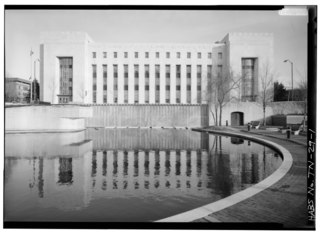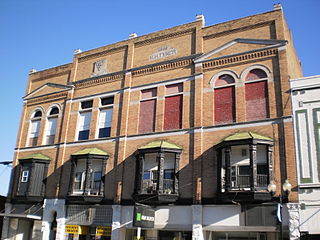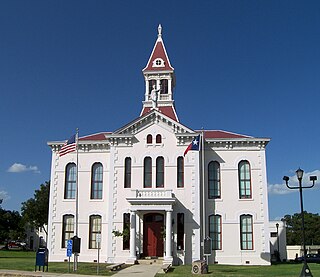Ooltewah is a census-designated place (CDP) in Hamilton County, Tennessee, United States. It is a suburb of Chattanooga. The population was 687 at the 2010 census. Ooltewah is an enclave in the city of Collegedale.

Sevierville is a city in and the county seat of Sevier County, Tennessee, located in Eastern Tennessee. The population was 14,807 at the 2010 United States Census and 17,117 according to the 2019 census estimate.

James County was created by an act of the Tennessee General Assembly on January 30, 1871. Lands were taken from a small portion of Bradley County and the eastern third of Hamilton County. James County was named in honor of the Rev. Jesse J. James, the father of Elbert Abdiel James, who introduced legislation for the formation of the county. Ooltewah was selected as the county seat.

Marr & Holman was an architectural firm in Nashville, Tennessee known for their traditional design. Notable buildings include the Nashville Post Office, now known as the Frist Center for the Visual Arts and the Milliken Memorial Community House in Elkton, Kentucky.

The United Church, Chapel on the Hill in Oak Ridge, Tennessee was the city's main church during World War II. Dedicated on September 30, 1943 and completed late in October 1943, it was originally a multi-denominational chapel shared by Catholic, Protestant and Jewish congregations.

The Knox County Courthouse is a historic building located at 300 Main Street in Knoxville, Tennessee, United States. Built in 1886, it served as Knox County's courthouse until the completion of the City-County Building in 1980, and continues to house offices for several county departments. John Sevier, Tennessee's first governor, is buried on the courthouse lawn. The courthouse is listed on the National Register of Historic Places for its architecture and its role in the county's political history.

Reuben Harrison Hunt, also known as R. H. Hunt, was an American architect who spent most of his life in Chattanooga, Tennessee. He is considered to have been one of the city's most significant early architects. He also designed major public building projects in other states. He was a principal of the R.H. Hunt and Co. firm.

Tennessee marble is a type of crystalline limestone found only in East Tennessee, in the southeastern United States. Long esteemed by architects and builders for its pinkish-gray color and the ease with which it is polished, this stone has been used in the construction of numerous notable buildings and monuments throughout the United States and Canada, including the National Gallery of Art and the National Air and Space Museum in Washington, D.C., the Minnesota State Capitol, as well as parts of the United States Capitol in Washington, Grand Central Terminal in New York, and Union Station in Toronto. Tennessee marble achieved such popularity in the late-19th century that Knoxville, the stone's primary finishing and distribution center, became known as "The Marble City."

Pulaski County Courthouse is a Classical Revival building in Hawkinsville, Georgia dating from 1874. The building is located on the southwest corner of Commerce Street and North Lumpkin Street. It was listed on the National Register of Historic Places in 1980.

The Joel W. Solomon Federal Building and United States Courthouse, commonly referred to as the Solomon Building is a historic post office and courthouse located at Chattanooga, Tennessee in Hamilton County, Tennessee. The courthouse serves the United States District Court for the Eastern District of Tennessee. The building is listed on the National Register of Historic Places as U.S. Post Office. It was designed by Shreve, Lamb and Harmon and Reuben Harrison Hunt with watercolor murals by Hilton Leech.
Dwight James Baum (1886–1939) was an American architect most active in New York and in Sarasota, Florida. His work includes Cà d'Zan, the Sarasota Times Building (1925), Sarasota County Courthouse (1926), early residences in Temple Terrace, Florida, Sarasota County Courthouse (1927), Pinecroft, West Side YMCA on 63rd Street between Central Park and Columbus Avenue, Columbus Circle (1934) and Hendricks Memorial Chapel.

Asbury United Methodist Church, originally Highland Park Methodist Episcopal Church, is a historic church on Bailey Avenue in Chattanooga, Tennessee.

The Hartford City Courthouse Square Historic District is located in Hartford City, Indiana. Hartford City has a population of about 7,000 and is the county seat of Blackford County and the site of the county courthouse. The National Park Service of the United States Department of the Interior added the Hartford City Courthouse Square Historic District to the National Register of Historic Places on June 21, 2006 — meaning the buildings and objects that contribute to the continuity of the district are worthy of preservation because of their historical and architectural significance. The District has over 60 resources, including over 40 contributing buildings, over 10 non-contributing buildings, 1 contributing object, 8 non-contributing objects, and two other buildings that are listed separately in the National Register.

The Van Buren County Courthouse located in Keosauqua, Iowa, United States, was built in 1843. It was listed on the National Register of Historic Places in 1977 as a part of the County Courthouses in Iowa Thematic Resource. It is the only building the county has used as its courthouse, and it is the oldest courthouse in Iowa. In 1845 the courthouse served as the location for a trial resulting in the first death penalty in Iowa history.

The Baumann family was a family of American architects who practiced in Knoxville, Tennessee, and the surrounding region, in the late 19th and early 20th centuries. It included Joseph F. Baumann (1844–1920), his brother, Albert B. Baumann, Sr. (1861–1942), and Albert's son, Albert B. Baumann, Jr. (1897–1952). Buildings designed by the Baumanns include the Mall Building (1875), the Church of the Immaculate Conception (1886), Minvilla (1913), the Andrew Johnson Building (1930), and the Knoxville Post Office (1934).

The Wilson County Courthouse and Jail are located in Floresville, Texas. They were added to the National Register of Historic Places in Texas in 1978 and the courthouse as a Recorded Texas Historic Landmark in 1984.

The United States Post Office and Courthouse, commonly called the Knoxville Post Office, is a state building located at 501 Main Street in Knoxville, Tennessee, United States. Constructed in 1934 for use as a post office and federal courthouse, the building contains numerous Art Deco and Moderne elements, and is clad in Tennessee marble. While the building is still used as a branch post office, the court section is now used by the state courts. The building is listed on the National Register of Historic Places for its architecture and political significance.

The Hopkins County Courthouse is a historic courthouse located in Sulphur Springs, Texas, the seat of Hopkins County. It was designed by San Antonio-based architect James Riely Gordon and constructed in 1894 and 1895. The courthouse was built in the Romanesque Revival architectural style with red sandstone and pink granite, and its design includes a number of unusual features, such as a double-helix staircase, a clockless tower, and entrances that are located on its northwest and southwest corners, instead of on its sides.
White Oak Mountain is a mountain located in northwestern Georgia and southeastern Tennessee. The mountain is part of the Ridge and Valley Appalachians.



















